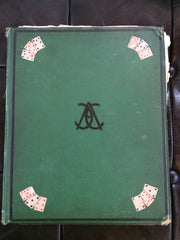The story behind the making of Games of Patience
Playing cards, their illustrations, and games have influenced and all been featured in Ron's art over the years. None more so than the series Games of Patience, which he created for an American benefactor and collector in the early 1980s.
Since his early days at Chelsea School of Art, Ron has been drawn to the art and design of cards throughout history. Incredibly, he still has the pages from a magazine in his student days, about medieval Arabian playing cards. Later, when on a trip to Spain, he was inspired by a visit to the Fournier Museum, which had been the largest card manufacturer in Europe. Here he picked up a considerable volume of the illustration of cards throughout history and he still has this today.


So, when the opportunity presented itself in 1981 to create a new series of work, he revisited his long-held fascination to develop his ideas for a playing card project. At this time, he was also a regular visitor to second-hand book stalls and had come across some engrossing books, with instructions on how to play games of patience (or solitaire) with detailed illustrations. You can see these below.
The illustrations and the accompanying written instructions within each of these volumes were the starting point and the formation of his ideas for the project. It then began to develop into series that highlighted and commented on the political and social matters that were on Ron's mind at that time.

With over 40 games studied, he laid out a set of cards, each to represent an individual game, and pin pricked ten cards whilst blindfolded. These were to be the games he would select and transform using the diagrams of the game and instructions juxtaposed against photo-images related to the title. He says "I subconsciously linked them to images, which turned out to be mostly of a social or political nature and focussed on victims of prejudice or persecution'.
The ten games he picked at random became translated into themes of human cruelty, objectification, war, sex, and circus. When asked Ron says his decisions were particularly influenced by the written instructions and how these became expressed in different human events, ideas, and behaviours. Here are some examples of how Ron responded to the original diagrams and instructions and images derived from newspaper and magazine shots.
Pyramid became a visual comment on trapeze and circus.
Dial became a comment on mistreatment of native Americans.
Nestor was a comment on female writers behind the then Iron Curtain.
The Star became a comment on the devastation of the holocaust. The text was taken from a book entitled KL Auschwitz which Ron bought on a Borough market stall, from by a former victim of the concentration camp. Other images from the book were also used for a work with poet George Szirtes in their collaboration The Burning of the Books, published by Circle Press based on the Nobel Prize winning novel by Elias Canetti "Auto da Fé".
The blank spaces, as shown in the Patience Games book, are filled with portraits of famous writers and poets, which would have had works burnt in facist bonfires across Europe. The original for the photograph, shown in the print, was found in an old magazine in a deserted barn in France.
It was a powerful body of work and the books were donated to several American Universities as well as added to private collections. The prints are 30 x 20 cm and were screen printed on to Somerset mould-made paper in a vacuum-formed plastic portfolio.
Ron also did some original drawings of which this is an one example.














